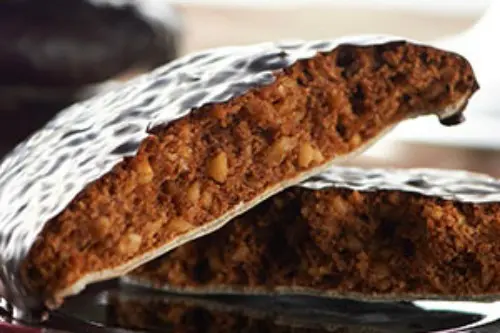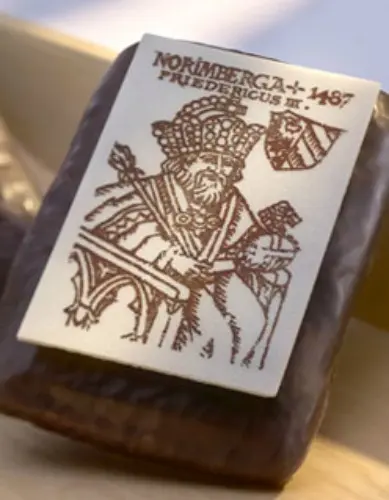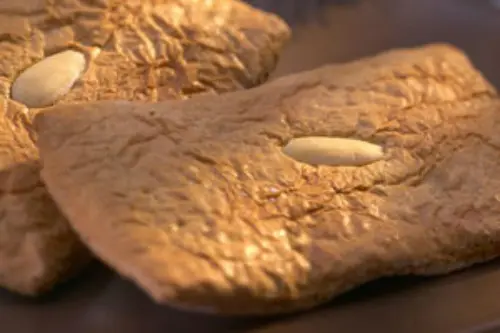Do you have German roots? Reconnect with your German roots or try a new Christmas tradition by baking these traditional German Lebkuchen Cookies this holiday season. There are several types of sweet, spicy, delicious Christmas Lebkuchen cookies. This Lebkuchen recipe is for a White Traditional Lebkuchen.
About German Lebkuchen Cookies
Even if you’re not German, you should try out German Lebkuchen Cookies. It’s rich past makes the eating like a history lesson in itself!
If you don’t know much about this cookie, let me fill you in.
What is known in Germany today as Lebkuchen is also known as Honigkuchen (honey cake), Pfefferkuchen (pepper cake), or as German gingerbread.
‘Kuchen’ means ‘cake,’ but there is dispute as to where the beginning ‘Leb’ came from. It is believed to have been one of these German words: Lebbe-, meaning “very sweet,” Laib-, meaning “loaf,” or Leben-, meaning “life.” All are appropriate, as the cookie is very bread-like and even cake-y. What Lebkuchen stemmed from were honey cakes, prized by ancient Greeks, Romans, and Egyptians and believed by them to be infused with healing powers and capable of warding off evil spirits. They were even thought to bring good luck, and were worn on necklaces by those entering into battle.
The Lebkuchen as we know it today is said to have originated in Belgium, and then introduced to and improved by monks in 13th century Franconia, Germany. From there, it spread to all over Germany where it is still a traditional and delicious holiday treat.
Types of Traditional Lebkuchen Recipes:
Today, there are several different types of Lebkuchen, but the Traditional Lebkuchen Recipe ingredients still include:
- Honey, flour, sugar, and eggs
- Cinnamon, cloves, anise, cardamom, coriander, ginger, nutmeg, and allspice
- Almonds, hazelnuts, and/or walnuts
- Candied lemon peel and orange peel
Sounds incredible, right!?
Oblaten Lebkuchen Cookies
To prevent the dough from sticking to the cookie pan, it was baked on “Oblaten,” or thin wafers. They can be enjoyed plain, glazed, or covered in chocolate.
Elisen Lebkuchen
As the highest quality of Oblaten Lebkuchen available, Elisen Lebkuchen must contain 25% of only almonds, hazelnuts, and/or walnuts, no other nut is used, and be no more than 10% flour. Now that’s a heavy cookie.

Kaiserlein Lebkuchen
These are Lebkuchen that are baked in the city of Nürnberg. Kaiserlein Lebkuchen are the best known because local history tells of Emperor Freidrich III handing out four thousand of these cookies to the children of Nuremberg all imprinted with his image. They have a soft and light texture with a picture drawn or imprinted. Nürnberger Lebkuchen are known for their high-quality ingredients, including nuts (like almonds or hazelnuts), honey, and a fragrant blend of spices such as cinnamon, cloves, and nutmeg.

Brown (Braune) Lebkuchen
You make Brown Lebkuchen cookie dough with plenty of honey or syrup. After baking, the cookies are covered with a sugar glaze or chocolate.

White (Weisse) Lebkuchen
These cookies get their name from their very light color, which comes from the dough’s large amount of eggs or egg whites. You can decorate White Lebkuchen with almonds, candied lemon, and/or orange peels.

My grandmother’s authenic lebkuchen recipe most closely resembles the White Lebkuchen. She shapes hers into rectangles, loads them with chopped nuts, spices, and honey, lathers them in a glaze and places a whole almond in the center.
While these delectable cookies take a bit of work and time to make, they are easily worth it and I challenge you to try it! Give your kids a glance at their history, or try out another culture’s custom!
This recipe makes 5 dozen cookies.
Prep time: approx 20 min, cook time: 10 min, ready in 10 hours.
German White Traditional Lebkuchen Recipe:
- 1/2 cup honey
- 1/2 cup molasses
- 3/4 cup packed brown sugar
- one egg
- 1 tablespoon lemon juice
- 1 teaspoon lemon zest
- 2 3/4 cups all-purpose flour
- 1/2 teaspoon baking soda
- one teaspoon ground cinnamon
- one teaspoon ground cloves
- 1 teaspoon ground allspice
- 1 teaspoon ground nutmeg
- 1/3 cup diced candied citron
- 1/3 cup chopped hazelnuts
For Icing: - 1 cup white sugar
- 1/2 cup water
- 1/4 cup confectioners’ sugar
How To Make These Traditional German Cookies:
- In a medium saucepan, stir the honey and molasses together. Bring the mixture to a boil then remove from heat. Stir in the brown sugar, egg, lemon juice and lemon zest. In a large bowl, stir together the flour, baking soda, cinnamon, cloves, allspice, and nutmeg. Add the molasses mixture to the dry ingredients and mix well. Stir in the citron and hazelnuts. Cover dough and chill overnight.
- Preheat oven to 350 degrees F (175 degrees C). Grease baking sheets. Using a small amount of dough at a time, roll out on a lightly floured surface to 1/4 inch thickness. Cut into small rectangles and place them 1 inch apart onto the prepared cookie sheet.
- Bake for 10 to 12 minutes in the preheated oven, until no imprint remains when touched lightly. Brush the icing over the cookies while they are still hot and quickly remove them to wire cooling racks. Store in airtight container with a cup of orange or apple for a few days to mellow.
Icing Instructions
Here’s how to make the icing for this traditional german Christmas treat.
Combine the sugar and water in a small saucepan. Heat to between 234 and 240 degrees F (112 to 116 degrees C), or until a small amount of syrup dropped into cold water forms a soft ball that flattens when removed from the water and placed on a flat surface.
Remove from heat and stir in the confectioners’ sugar.
Brush the top of the cookies with this thin icing. If icing becomes sugary while brushing cookies, re-heat slightly- adding a little water until crystals dissolve. Allow to cool, serve, and enjoy.
Conclusion
Lebkuchen cookies are a delightful treat that blend centuries of Christmas time tradition with rich, aromatic flavors. Their soft texture, warm spices, and hints of honey or glaze make them a perfect choice for those looking to experience the magic of festive European baking. Whether you’re celebrating the holidays, exploring cultural delicacies, or simply craving something unique, Lebkuchen cookies offer a satisfying and memorable indulgence worth savoring.
It is fun to try the various types of these traditional German Christmas cookies. Have you had German Lebkuchen Cookies before? Which variation of the Traditional Lebkuchen Recipe do you think will be your favorite?
Article Resources:
Photos via http://www.lebkuchen-schmidt.com/Lebkuchensorten/
http://germanfood.about.com/od/adventandchristmas/ss/nuernberger_lebkuchen.htm#step-heading
http://en.wikipedia.org/wiki/Lebkuchen
http://www.germanfoodguide.com/lebkuchen.cfm
More Christmas Cookie Recipes:
Easy Soft Pumpkin Chocolate Chip Cookies

Business brokers miami says
These Lebkuchen cookies look absolutely beautiful and so authentic! I love that you included the traditional recipe with all the warming spices like cardamom and anise—it really captures the essence of a German Christmas. The tips about letting the dough rest and the different glaze options are so helpful for getting that perfect, soft texture and classic finish. Baking these is such a wonderful way to create holiday memories.
Chan says
The Lebkuchen tradition began in medieval Germany, specifically in the city of Nuremberg (Nürnberg), in the late 13th century. Monks influenced the recipe and its popularity throughout Germany.
agromech industries says
This recipe and story around Lebkuchen are so warm and festive that you can almost smell the spices through the screen. The way you explain the German Christmas tradition behind these cookies, along with clear step-by-step instructions and accessible ingredients, makes it feel truly doable for home bakers who want to bring a bit of Germany to their own holiday table. Thank you for sharing such a cozy, nostalgic treat that beautifully blends culture, history, and delicious baking.
Pearl Marry says
This post beautifully captures the heart of German Christmas. The description of Lebkuchen, with its rich spices and festive aroma, instantly transported me. It’s more than a cookie; it’s a taste of tradition and warmth. Thank you for sharing this delicious piece of holiday heritage.
Danish says
Such a lovely portrayal of German Christmas. The mention of Lebkuchen instantly evokes festive warmth and tradition. A beautiful reminder that it’s more than just a cookie.